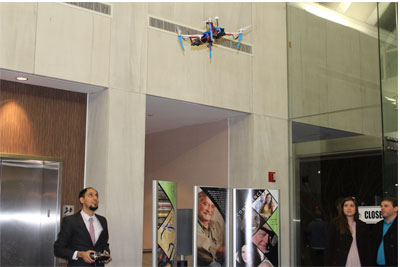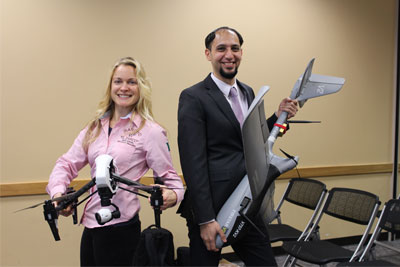“Who thinks drones are bad?”
That’s how UAB graduate student Ali Darwish began his presentation at the first Discoveries in the Making in the Hoover Public Library on Feb. 8, 2016. The new event was created by the UAB Graduate School to share the research UAB graduate trainees are exploring with the Birmingham community.
 Ali, a doctoral candidate in a joint UAB and UAH computer engineering program, used the opportunity to talk about a project he hopes will change the public perception of drones as invasive or destructive.
Ali, a doctoral candidate in a joint UAB and UAH computer engineering program, used the opportunity to talk about a project he hopes will change the public perception of drones as invasive or destructive.
The Mission
Inspired by the terrible destruction and suffering of his native Syria, Ali looked to drones as a tool to send relief. The idea was to implement drone technology in an aid delivery mechanism. This plan draws from airlift operations that delivered aid to West Berlin at the end of World War II, using large cargo aircrafts. Using that same model today, however, would be costly, and bring with it a number of legal complications.
The way a colony of ants transports huge amounts of food, tiny morsels at a time, is a closer model to what Ali and his team envision for this project. The complete vision is to launch fleets of small, light drones from various sites, each carrying a 3-5 pound load of medicine or food. The fleets would be automated to travel into target sites in coordinated flight routines, drop their payloads equipped with parachutes for safe delivery, and return to their launch sites. This mission is also the vision a team of students from various U.S. universities with whom Ali collaborates to bring this project to life.
Drone Engineering
The kind of drone that would be needed for a humanitarian aid mission is not commercially available. The engineering and programing of the aircraft is the focus of Ali’s role in this project. With the support and guidance of Dr. Arie Nakhmani in UAB’s Department of Electrical and Computer Engineering, Ali has developed a number of model drones well suited for this mission. So how do you engineer this kind of drone?
As Ali tells us, there are three elements needed to build any drone: the air frame, a microcontroller with sensors, and software. In keeping with the goal of making these drones as cost effective as possible, Ali designed the air frame components so they can be 3-D printed, anywhere a 3-D printer is available. Each craft houses a microcontroller containing the sensors needed for navigation.

In Ali’s design, the microcontroller is a Raspberry Pi housing sensors that modulate speed, sense location, and perform space scanning functions to guide the craft. The functional capabilities of the microcontroller must be communicated by the user through software. Ali has developed the software needed to fly the craft on short flight paths using Dronecode’s open source project.
Currently, he is working on expanding the software capabilities to achieve longer flight paths and incorporate machine learning technology to, in a sense, teach the drone how to handle a number of simulated situations that may be encountered in flight. Development of a swarm technology that will enable drones to communicate and share information is also in the works.
Looking Ahead
Although the development of Ali’s drones may take some time, he and his collaborators are already making progress on reframing drones from inherently evil technology to tools for doing good. The project has additionally provided an opportunity to teach middle and high school students from local schools about drone technology. In fact, one of the drones Ali flew in the Hoover Public Library to demo the technology shortly before his talk, was assembled by a middle school student! Ali plans to finish his doctoral program next year and hopes to continue working toward a future in which drones are seen not as menaces, but as part of creative solutions to help people in a number of ways.